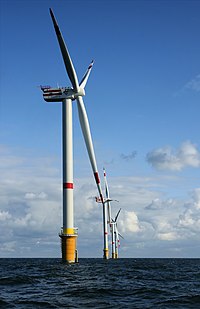
Photo from wikipedia
Wind turbine (WT) blades are vulnerable to failure as they are exposed to direct harsh environment, suffering constantly varying loads by wind and cyclic fatigue load due to self-weight, experiencing… Click to show full abstract
Wind turbine (WT) blades are vulnerable to failure as they are exposed to direct harsh environment, suffering constantly varying loads by wind and cyclic fatigue load due to self-weight, experiencing extreme temperature and humidity changes, erosion and corrosion. As a consequence, blades show high failure rate and share significant downtime, which highlight the significance and essentiality of the research, development and application of blade structural health monitoring (SHM) techniques. To fulfil reliable SHM of WT blades, much effort has been spent in the past years as reported in the literature. However, to date, how to realise reliable WT blade SHM is still an open question. The previous reviews enumerate the non-destructive testing techniques that are potentially applicable to blade SHM, but they fail to indicate which technique is most suitable for blade SHM and how to implement reliable SHM of a WT blade. To fill this gap, this study is geared toward to investigate the pros and cons of existing blade SHM techniques and following which, a newly developed blade SHM technique that is effective in both damage detection and fault location is discussed.
Journal Title: Iet Renewable Power Generation
Year Published: 2017
Link to full text (if available)
Share on Social Media: Sign Up to like & get
recommendations!